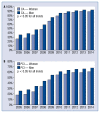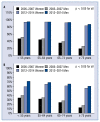Impact of routine invasive strategy on outcomes in patients with non-ST-segment elevation myocardial infarction during 2005-2014: A report from the Polish Registry of Acute Coronary Syndromes (PL-ACS)
- PMID: 30406936
- PMCID: PMC8078974
- DOI: 10.5603/CJ.a2018.0136
Impact of routine invasive strategy on outcomes in patients with non-ST-segment elevation myocardial infarction during 2005-2014: A report from the Polish Registry of Acute Coronary Syndromes (PL-ACS)
Abstract
Background: Non-ST-segment elevation myocardial infarction (NSTEMI) has become the most frequently encountered type of myocardial infarction. The patient clinical profile and management has evolved over the past decade. As there is still a scarcity of data on the latest trends in NSTEMI, changes herein were observed and assessed in the treatment and outcomes in Poland between 2005 and 2014.
Methods: A total of 197,192 patients with NSTEMI who enrolled in the Polish Registry of Acute Coronary Syndromes (PL-ACS) between 2005 and 2014 were analyzed. In-hospital and 12-month mortality were assessed.
Results: Coronary angiography use increased from 35.8% in 2005-2007 to 90.7% in 2012-2014 (p < 0.05), whereas percutaneous coronary intervention increased from 25.7% in 2005-2007 to 63.6% in 2012-2014 (p < 0.05). There was a 50% reduction in in-hospital mortality (from 5.6% in 2005-2007 to 2.8% in 2012-2014; p < 0.05) and a 30% reduction in 1-year mortality (from 19.4% in 2005-2007 to 13.7% in 2012-2014; p < 0.05). A multivariate analysis confirmed an immense impact of invasive strategy on patient prognosis during in-hospital observation with an odds ratio (OR) of 0.31 (95% confidence interval [CI] 0.29-0.33; p < 0.05) as well as during the 12-month observation with an OR of 0.51 (95% CI 0.49-0.52; p < 0.05).
Conclusions: Over the past 10 years, an important advance in the management of NSTEMI has taken place in Poland. Routine invasive strategy resulted in a significant decrease in mortality rates in all groups of NSTEMI patients.
Keywords: invasive strategy; non-ST-elevation myocardial infarction; outcomes; percutaneous coronary intervention; temporal trends.
Conflict of interest statement
Figures




References
-
- Bassand JP, Hamm CW, Ardissino D, et al. Guidelines for the diagnosis and treatment of non-ST-segment elevation acute coronary syndromes. Task Force for Diagnosis and Treatment of Non-ST-Segment Elevation Acute Coronary Syndromes of European Society of Cardiology. Eur Heart J. 2007;28(13):1598–660. - PubMed
-
- Hamm CW, Bassand JP, Agewall S, et al. ESC Guidelines for the management of acute coronary syndromes in patients presenting without persistent ST-segment elevation: The Task Force for the management of acute coronary syndromes (ACS) in patients presenting without persistent ST-segment elevation of the European Society of Cardiology (ESC) Eur Heart J. 2011;32(23):2999–3054. doi: 10.1093/eurheartj/ehr236. - DOI - PubMed
-
- Gierlotka M, Gąsior M, Wilczek K, et al. Temporal trends in the treatment and outcomes of patients With non-ST-segment elevation myocardial infarction in Poland from 2004–2010 (from the Polish Registry of Acute Coronary Syndromes) Am J Cardiol. 2012;109(6):779–786. doi: 10.1016/j.amjcard.2011.10.041. - DOI - PubMed
-
- Puymirat E, Simon T, Cayla G, et al. Management, and 6-Month Outcomes Over a Period of 20 Years in the FAST-MI Program (French Registry of Acute ST-Elevation or Non-ST-Elevation Myocardial Infarction) 1995 to 2015. Circulation. 2017;136(20):1908–1919. doi: 10.1161/circulationaha.117.030798. - DOI - PubMed
MeSH terms
LinkOut - more resources
Full Text Sources
Medical
Research Materials
Miscellaneous

